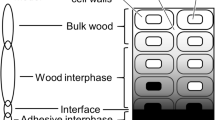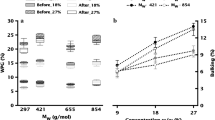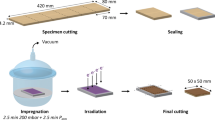Summary
The ability of a novel water-borne alkyd resin to penetrate the first and second order void volumes ofTilia americana L. andPinus strobus L. is documented. Penetration of the gross capillary system of both species is evidenced by the creation of high resolution, negative alkyd resin replicas of cell lumina, pit openings and cell wall surface detail. Infiltration of the transient cell wall capillaries present in saturated wood elements is demonstrated by the achievement of moderate antiswell efficiencies of up to 37 percent in small wafers of basswood and 27 percent in Eastern white pine wafers. The alkyd resin without metallic salt driers was present in the cell wall in a non-bonded, and therefore, leachable form. Cell type, character and frequency were found to influence antiswell efficiency and weight percent gain in both species. A low initial wood moisture content and a high resin solids content are requisite for achievement of greater dimensional stability.
Similar content being viewed by others
References
Bailey, I. W. 1938: Cell wall structure of higher plants. Ind. Engin. Chem. 30 (1): 40–47
Bailey, I. W. 1939: The microfibrillar and microcapillary structure of the cell wall. Bull. Torrey Botan. Club 66: 201–213
Bailey, I. W. 1957: Aggregations of microfibrils and their orientations in the secondary wall of coniferous tracheids. Amer. J. Botany 44: 415–418
Côté, W. A.; Krahmer, R. L. 1962: The permeability of coniferous pits demonstrated by electron microscopy. TAPPI 45 (2): 119–122
Cowling, E. B.; Stamm, A. J. 1963: An approach to the measurement of solid-solution structures in wood and other cellulosic materials. J. of Polymer Sci. Part C., 2: 243–252
Davies, G. W. 1968: Electron microscopy and cell wall porosity. APPITA 21 (4): 117–130
Frey-Wyssling, A. 1937: Über die röntgenometrische Vermessung der submicroskopischen Räume in Gerüstsubstanzen. Protoplasma 27: 372–411
Kellogg, R. M.; Wangaard, F. F. 1969: Variation in the cell wall density of wood. Wood Fiber 1: 180–204
Panshin, A. J.; deZeeuw, C. 1980: Textbook of wood technology. Vol I. Fourth Ed. New York: McGraw-Hill Inc.
Rowell, R. M.; Ellis, W. D. 1978: Determination of dimensional stabilization of wood using the water-soak method. Wood Fiber 10: 104–111
Rowell, R. M.; Gutzmer, D. I.; Sachs, I. B.; Kinney, R. E. 1976: Effects of alkylene oxide treatments on dimensional stability of wood. Wood Sci. 9 (1): 51–54
Rudman, P. 1966a: Studies in wood preservation. Part II: Movement of aqueous solutions through the pits and cell walls of Eucalypt sapwoods. Holzforschung 20: 57–60
Rudman, P. 1966b: Studies in wood preservation. Part III: The penetration of the fine structure of wood by inorganic solutions, including wood preservatives. Holzforschung 20: 60–67
Stamm, A. J. 1934: Effect of inorganic salts on the swelling and shrinking of wood. J. Amer. Chem. Soc. 56: 1195–1204
Stamm, A. J. 1959: Effect of polyethylene glycol on the dimensional stability of wood. Forest Prod. J. 9: 375–381
Stamm, A. J. 1964a: Wood and cellulose science. New York: Ronald Press
Stamm, A. J. 1964b: Factors affecting the bulking and dimensional stabilization of wood with polyethylene glycols. Forest Prod. J. 14: 403–408
Stone, J. E.; Scallan, A. M. 1965: A study of cell wall structure by nitrogen adsorption. Pulp Paper Mag. Canada 66: T407-T414
Stone, J. E.; Scallan, A. M. 1968: A structural model for the cell wall of water-swollen wood pulp fibers based on their accessibility to macromolecules. Cellul. Chem. Technol. 2: 343–358
Taneda, K.; Kawakami, H.; Ishida, S.; Ohtani, J. 1979: Observation of the polymer in woodpolymer composite. I: Dissolution of wood substance in WPC and shape of the polymer cast. Mokuzai Gakkaishi, J. of Jap. Wood Res. Soc. 25: 209–215
Tarkow, H.; Feist, W. C.; Southerland, C. F. 1960: Interaction of wood with polymeric materials: Penetration versus molecular size. Forest Prod. J. 16 (10): 61–65
Thomas, R. J. 1976: Anatomical features affecting liquid penetrability in three hardwood species. Wood Fiber 7: 256–263
Author information
Authors and Affiliations
Additional information
This paper is based in part on the thesis research conducted by the first author in partial fulfillment of the requirements for the Master of Science degree at the State University of New York College of Environmental Science and Forestry, Syracuse, N.Y.
Rights and permissions
About this article
Cite this article
Smulski, S., Côté, W.A. Penetration of wood by a water-borne alkyd resin. Wood Sci.Technol. 18, 59–75 (1984). https://doi.org/10.1007/BF00632131
Received:
Issue Date:
DOI: https://doi.org/10.1007/BF00632131




